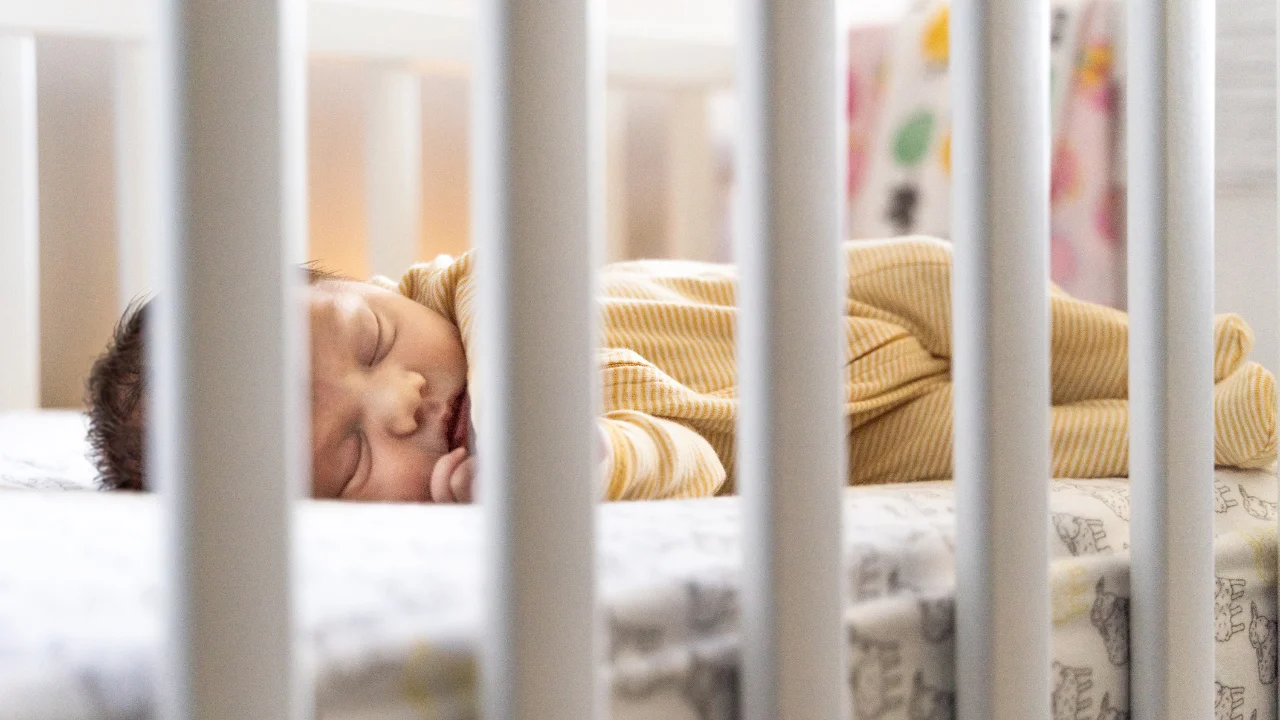
ድንገተኛ የጨቅላ ሕጻናት ሞት ሲንድረም (SIDS) ከ1 ዓመት በታች የሆነ ጤነኛ የሚመስለው ሕፃን ድንገተኛ እና ምክንያቱ ሳይገለጽ ሞት ነው። SIDS አብዛኛውን ጊዜ የሚከሰተው በእንቅልፍ ወቅት ነው፣ እና ያለ ማስጠንቀቂያ ይከሰታል፣ ይህም በተለይ ከባድ ያደርገዋል። ምንም እንኳን SIDSን መከላከል ባይችሉም ለህፃናት አስተማማኝ የእንቅልፍ ልምዶችን በመጠቀም የልጅዎን ስጋት በእጅጉ ሊቀንሱ ይችላሉ። የመጀመሪያው እርምጃ ልጅዎን ሁል ጊዜ በጀርባው ላይ በማድረግ ደህንነቱ በተጠበቀ አልጋ፣ ባሲኔት ወይም የጨዋታ ጓሮ ውስጥ ያለ አልጋ ልብስ እንዲተኛ ማድረግ ነው።
በዚህ ጽሑፍ ውስጥ
- ድንገተኛ የጨቅላ ሕጻናት ሞት ሲንድሮም (SIDS) ምንድን ነው?
- የSIDS መንስኤ ምንድን ነው?
- የSIDS ስጋትን እንዴት መቀነስ እችላለሁ?
- የሲአይኤስ አደጋ በእድሜ
ድንገተኛ የጨቅላ ሕጻናት ሞት ሲንድሮም (SIDS) ምንድን ነው?
ድንገተኛ የጨቅላ ሕጻናት ሞት ሲንድሮም (SIDS) ከ 1 ዓመት በታች የሆነ ህጻን በድንገት ሲሞት እና ትክክለኛ መንስኤ ሊገኝ በማይችልበት ጊዜ የሚሰጠው ምርመራ ነው።
ከ 2 እስከ 4 ወር እድሜ ያላቸው ህጻናት ለSIDS በጣም የተጋለጡ ናቸው, እና 90 በመቶዎቹ ጉዳዮች ከ6 ወር በታች በሆኑ ህጻናት ላይ ይከሰታሉ.
ከ1992 ጀምሮ በSIDS የሚሞቱ ጨቅላ ሕፃናት ቁጥር ከግማሽ በላይ ቀንሷል - ያኔ ነው የሕፃናት ሕክምና ሕፃናትን በጀርባቸው እንዲተኙ ሲመክሩት - ነገር ግን SIDS አሁንም ከ 1 ዓመት በታች ለሆኑ ሕፃናት ሞት ዋነኛው መንስኤ ነው።
SIDS በአብዛኛው በእንቅልፍ ጊዜ ወይም በሕፃን እንቅልፍ አካባቢ በሚሆኑት ድንገተኛ ያልተጠበቁ የሕፃናት ሞት (SUIDs) ሰፊ ምድብ ስር ነው። SUIDs በተጨማሪም በአጋጣሚ በመታፈን ወይም በመታፈን እና ባልታወቀ ምክንያት የሚሞቱ ሰዎችንም ያጠቃልላል።
እንደ የበሽታ መቆጣጠሪያ እና መከላከያ ማእከል (ሲዲሲ) በ SUIDS በየዓመቱ ወደ 3,400 የሚጠጉ ህጻናት ይሞታሉ። ይህ ቁጥር አሳዛኝ ቢሆንም - እና ለአዳዲስ ወላጆች አስፈሪ ሊሆን ይችላል - ይህ በልጅዎ ላይ ሊከሰት የማይችል መሆኑን ማስታወስ አስፈላጊ ነው.
እና፣ SIDSን ለመከላከል ምንም አይነት ትክክለኛ መንገድ ባይኖርም፣ የልጅዎን ስጋት ለመቀነስ አስፈላጊ እርምጃዎችን መውሰድ ይችላሉ።
የSIDS መንስኤ ምንድን ነው?
ተመራማሪዎች ስለ SIDS ብዙ ተምረዋል, ነገር ግን መንስኤው ምን እንደሆነ ግልጽ መልስ የላቸውም.
አብዛኞቹ ባለሙያዎች SIDS አንድ ሕፃን ከስር አካላዊ ተጋላጭነት (እንደ ያልበሰለ ወይም ያልተለመደ የልብ ሥራ, አተነፋፈስ, ወይም መነቃቃትን ያሉ) እና አንዳንድ አስጨናቂ ሁኔታዎች (እንደ ሆድ ወደ ታች መተኛት ወይም በጣም ሞቅ ያለ ልብስ መልበስ) ሲጋለጥ እንደሆነ ያምናሉ.
የቅርብ ጊዜ ጥናቶች እንደሚያሳዩት የአንጎል ኬሚካል ሴሮቶኒን በቂ ያልሆነ መጠን አንድን ሕፃን ለ SIDS የበለጠ ተጋላጭ ያደርገዋል። በSIDS ከሚሞቱት ሕፃናት እስከ 70 በመቶ የሚደርሱት በአንጎል ግንድ ውስጥ ያለው የሴሮቶኒን መጠን ከመደበኛው ያነሰ መሆኑን ባለሙያዎች አረጋግጠዋል። ሴሮቶኒን በእንቅልፍ ወቅት የአተነፋፈስ, የልብ ምት እና የደም ግፊትን ለመቆጣጠር ይረዳል.
ተመራማሪዎች ለSIDS የተለመዱ አደገኛ ሁኔታዎችን እና ልጅዎን የሚከላከሉባቸውን መንገዶችም ለይተው አውቀዋል።
የ SIDS አደጋ ምክንያቶች
- ያለጊዜው መሆን; ቀደም ብለው የተወለዱ እና ዝቅተኛ ክብደት ያላቸው ሕፃናት ለአደጋ የተጋለጡ ናቸው።
- ዕድሜ፡- ዕድሜያቸው ከ 4 ወር በታች የሆኑ ሕፃናት ከፍተኛ ተጋላጭ ናቸው።
- ጾታ ወንዶች ልጆች ከሴቶች ይልቅ ትንሽ ከፍ ያለ አደጋ ላይ ናቸው.
- መንታ መሆን። መንትዮች ለሲአይኤስ ተጋላጭነት በእጥፍ ይጨምራሉ፣ ይህም በአብዛኛው መንትዮች ዝቅተኛ የወሊድ ክብደት ምክንያት ነው።
- የእናቶች ምክንያቶች፡- በእርግዝና ወቅት የሚያጨሱ ወይም አደንዛዥ ዕፅ ወይም አልኮሆል የተጠቀሙ፣ በቂ የቅድመ ወሊድ እንክብካቤ ያልነበራቸው ወይም ከ20 ዓመት በታች የሆኑ ሴቶች ሲወልዱ ለአደጋ የተጋለጡ ናቸው።
- የቤተሰብ ታሪክ፡- በSIDS የሞቱ ወንድም እህት ወይም የአጎት ልጅ ያላቸው ሕፃናት ከፍተኛ ተጋላጭ ናቸው።
- ዘር ጥቁር፣ አሜሪካዊ ወይም የአላስካ ተወላጅ ለሆኑ ጨቅላ ሕፃናት የSIDS አደጋ ከፍተኛ ሲሆን ከዚያም ነጭ ይከተላል። የእስያ/የፓሲፊክ ደሴት እና የሂስፓኒክ ጨቅላ ህፃናት ለአደጋ የተጋለጡ ናቸው።
- የሁለተኛ እጅ ጭስ; ከአጫሾች ጋር የሚኖሩ ሕፃናት ለአደጋ የተጋለጡ ናቸው።
የSIDS ስጋትን እንዴት መቀነስ እችላለሁ?
የልጅዎን የSIDS እና ሌሎች ከእንቅልፍ ጋር በተያያዙ የሞት አደጋዎችን ለመቀነስ ከህፃናት ሐኪም የሚሰጠውን አስተማማኝ የእንቅልፍ ምክሮችን ይከተሉ። እንዲሁም ሁሉም የልጅዎ ተንከባካቢዎች እነዚህን መመሪያዎች መከተላቸው በጣም አስፈላጊ ነው፣ ዘመዶች፣ ሞግዚቶች እና የልጆች እንክብካቤ አቅራቢዎች እንደ ሞግዚቶች እና የመዋዕለ ሕፃናት ሰራተኞች።
ከ15 እስከ 20 በመቶ የሚሆነው የSIDS ሞት የሚከሰቱት በልጆች እንክብካቤ መስጫ ቦታዎች ነው። ሕፃናት በመዋዕለ ሕጻናት ውስጥ በእንቅልፍ የሚያሳልፉት ጊዜ እቤት ውስጥ ከሚያሳልፉት ያነሰ መሆኑን ግምት ውስጥ በማስገባት ይህ በሚያስደንቅ ሁኔታ ከፍተኛ ቁጥር ነው። ይህ አሀዛዊ መረጃ እንደሚያሳየው ልጅዎን የሚንከባከቡ ሁሉ ለህፃናት ደህንነቱ የተጠበቀ የእንቅልፍ ልምዶችን መከተላቸውን ማረጋገጥ ምን ያህል አስፈላጊ እንደሆነ ያሳያል።
የSIDS ስጋትን ለመቀነስ፡-
- ልጅዎን በጀርባው ላይ እንዲተኛ ያድርጉት. ልጅዎን ለመጠበቅ ሊረዱት ከሚችሉት በጣም አስፈላጊ ነገሮች አንዱ ይህ ነው። ከጀርባው ይልቅ ሆዳቸው ላይ ቢተኛ ህጻን ለሲአይኤስ ተጋላጭነት ከሁለት እስከ 13 እጥፍ ከፍ ያለ ነው። አንድ ሕፃን ሆድ ወደ ታች ሲተኛ፣ ከመጠን በላይ የመሞቅ ዕድላቸው ከፍተኛ ነው፣ ትንፋሹ ቆም ይላል እና ትንሽ የመነቃቃት ስሜት ይኖረዋል፣ እና ያወጡትን አየር እንደገና ይተነፍሳሉ፣ ይህም አነስተኛ ኦክሲጅን ይዟል።
- አልጋህን ከልጅህ ጋር አታጋራ። ከከፍተኛ የSIDS አደጋ እና ድንገተኛ መታፈን፣ መታፈን ወይም መጠመድ ጋር የተያያዘ ነው። የሕፃናት ሐኪሞች ልጅዎ በክፍልዎ ውስጥ እንዲተኛ ይመክራሉ, ነገር ግን በአልጋዎ ላይ አይደለም, በምሽት ቢያንስ በመጀመሪያዎቹ ስድስት ወራት እና ለመጀመሪያው አመት. የልጅዎን አልጋ፣ ባሲኔት ወይም የጨዋታ ጓሮ በክፍልዎ ውስጥ፣ ወደ አልጋዎ ይዝጉ። ይህ ዝግጅት የSIDS ስጋትን በግማሽ ሊቀንስ ይችላል።
- ጠንካራ፣ ጠፍጣፋ የመኝታ ቦታ ይጠቀሙ። ልጅዎን በእነሱ ስር የተገጠመ አንሶላ ብቻ ባለው ጠንካራ እና ጠፍጣፋ ፍራሽ ላይ እንዲተኛ ያድርጉት። (ከዳይፐር ፍንጣቂዎች ለመከላከል ቀጭን እና ጥብቅ የሆነ የፍራሽ ንጣፍ ከላጣው ስር ማስቀመጥ ምንም ችግር የለውም።) ልጅዎ በመጫወቻ ጓሮ ወይም ባሲኔት ውስጥ የሚተኛ ከሆነ ከእሱ ጋር የሚመጣውን ንጣፍ ብቻ ይጠቀሙ - ምንም ተጨማሪ ትራስ ወይም ንጣፍ የለም። የሕፃን አልጋ መከላከያ ወይም ዘንበል ያለ እንቅልፍ የሚወስዱ አይጠቀሙ - ሁለቱም ለሕፃናት አደገኛ ናቸው እና በዩኤስ ውስጥ ታግደዋል
- የልጅዎን የመኝታ ቦታ ባዶ ያድርጉት። ልጅዎ ለስላሳ አልጋዎች፣ የሕፃን አልጋ መከላከያዎች፣ ልቅ ብርድ ልብሶች፣ የታሸጉ እንስሳት ወይም ትራሶች እንዲተኛ አይፍቀዱለት። ወደ መታፈን፣ ወደ መታፈን ወይም ወደ ማሰር ሊመሩ ይችላሉ። ልጅዎ ለማሞቅ ሌላ ሽፋን ከፈለገ፣ ማጠፊያ ወይም የእንቅልፍ ማቅ ይጠቀሙ። ማሳሰቢያ: አይጠቀሙ ክብደት ያለው የሚያንቀላፋ፣ ስዋድል ወይም የእንቅልፍ ቦርሳ - ኤኤፒ እነዚህ ምርቶች ደህንነታቸው የተጠበቀ እንዳልሆኑ ይናገራል። እና ልጅዎ ወደ 2 ወር አካባቢ ለመንከባለል ሲቃረብ መዋጥዎን ያቁሙ።
- ደህንነቱ የተጠበቀ የሕፃን አልጋ፣ የባሲኔት ወይም የጨዋታ ጓሮ ይምረጡ። ደህንነታቸው የተጠበቁ ምርቶችን ስለመግዛት ጠቃሚ ምክሮችን ለማግኘት ጽሑፎቻችንን በምርጥ ገንዳዎች፣ አልጋዎች እና play yard ላይ ይመልከቱ። እንዲሁም የልጅዎን የመኝታ አካባቢ ከአደጋ ነጻ ለማድረግ የቤትዎን ልጅ ስለመጠበቅ የእኛን ምክሮች ያንብቡ።
- ከልጅዎ ጋር በአልጋ፣ ተንሸራታች ወይም በክንድ ወንበር ላይ አይተኛ። እነዚህ የተደላደሉ አካባቢዎች ለሲአይኤስ ወይም የመታፈን ስጋት ስለሚጨምሩ ለአራስ ሕፃናት አደገኛ ናቸው። እንቅልፍ ሲያጡ ልጅዎን በሶፋ ወይም ምቹ በሆነ ወንበር ላይ አይያዙ ወይም አይመግቡ, ምክንያቱም በቀላሉ ሊተኙ ይችላሉ. ብርድ ልብሶችን እና ትራሶችን ጨምሮ ልጅዎን ወደ አልጋው ወደተራቆተ አልጋ ማምጣት የተሻለ ነው።
- ልጅዎን ከመጠን በላይ ማሞቅ ያስወግዱ. ልጅዎን ለመተኛት ከአንድ በላይ በሆነ ንብርብር ይልበሱት በዚያ አካባቢ ምቾት እንዲኖርዎት አዋቂ ሰው ከሚለብሰው በላይ። እንደ ላብ፣ እርጥብ ፀጉር፣ ወይም ለመዳሰስ የሚሞቅ ደረትን የመሳሰሉ ከመጠን በላይ የማሞቅ ምልክቶችን ይመልከቱ። የሕፃን ኮፍያ ለብሶ አልጋ ላይ አያስቀምጡት - ይህ አስፈላጊ አይደለም እና ከመጠን በላይ ሙቀትን ያስከትላል።
- ልጅዎን በመኪና መቀመጫ፣ በጋሪ፣ በመወዛወዝ ወይም በመወርወሪያው ላይ እንዲተኛ አይፍቀዱለት። ይህ በተለይ ከ 4 ወር በታች ለሆኑ ህጻናት አስፈላጊ ነው. ጨቅላ ህጻናት በተዘበራረቀ ሁኔታ ውስጥ ቢተኛ መታፈን ይችላሉ። ልጅዎ ከእነዚህ ምርቶች ውስጥ በአንዱ ውስጥ ቢተኛ በተቻለ ፍጥነት ወደ አልጋ አልጋ፣ ባሲኔት ወይም የጨዋታ ጓሮ ያስተላልፉ።
- ልጅዎን ከሲጋራ እና ከትንፋሽ ያርቁ። ጥናቶች እንደሚያሳዩት ህጻን በሲጋራ ውስጥ ያለው እያንዳንዱ ተጨማሪ አጫሽ ፣በየቀኑ በዙሪያቸው በሚያጨሱት የሲጋራዎች ብዛት እና ለሲጋራ ጭስ የመጋለጥ ርዝማኔ ሲጨምር የሕፃኑ የSIDS አደጋ ይጨምራል። ኤኤፒ በተጨማሪም ከህፃን ጋር የሚኖር ማንኛውም ሰው ከትዝብት መራቅ (ህፃናትን ለኒኮቲን ሊያጋልጥ ይችላል) እንዲሁም ማሪዋና፣ ኦፒዮይድስ፣ አልኮሆል እና ህገወጥ እጾች እንዳይወስዱ ይመክራል።
- ከቻልክ ጡት ማጥባት። ጡት በሚያጠቡ እና በሚረዝሙ ቁጥር፣ ልጅዎ ከSIDS የበለጠ ጥበቃ ይኖረዋል። ሜታ-ትንተና ቢያንስ ለሁለት ወራት ጡት ያጠቡ ሕፃናት የSIDS እድላቸውን በግማሽ ይቀንሳሉ፣ ምንም እንኳን ህፃናቱ ጡት ብቻ ባይጠቡም እንኳ። ከሁለት ወር በላይ ጡት ማጥባት ተጨማሪ ጥበቃን ሰጥቷል.
- ልጅዎ መከተቡን ያረጋግጡ። መረጃዎች እንደሚያመለክቱት በልጅዎ የተመከሩትን ክትባቶች በጊዜ መርሐግብር ማግኘት ከSIDS ሊከላከል ይችላል።
- የመኝታ ጊዜ ሲደርስ ለልጅዎ ማስታገሻ ይስጡት። ጥናቶች እንደሚያሳዩት በሚጠቀሙ ጨቅላ ሕፃናት መካከል የSIDS በሽታ ዝቅተኛ ነው። ማስታገሻዎችምንም እንኳን ባለሙያዎች ቀጥተኛ መንስኤ እና ውጤት መኖሩን ባያውቁም. በተዛማጅነት ምክንያት፣ ለልጅዎ እንቅልፍ ሲወስዱ እና ለመጀመሪያው የህይወት አመት በመኝታ ጊዜ - ልጅዎ እስከወደደው ድረስ እና ከልጅዎ ልብስ ወይም ከታሸገ እንስሳ ጋር ያልተያያዘ ደህንነቱ የተጠበቀ ማጥፊያ እንዲሆን ኤኤፒ ይጠቁማል።
- የቤት ውስጥ እንቅልፍ መቆጣጠሪያን አይጠቀሙ. ተለባሾችን ጨምሮ የልብ ምት መቆጣጠሪያዎች በሰፊው ይሸጣሉ - ልክ እንደ “ደህና እንቅልፍ” ምርቶች የሚተዋወቁ ሌሎች ማሳያዎች። አንዳንዶቹ የተነደፉት በአልጋው ውስጥ የሕፃኑን እንቅስቃሴ ለመለየት እና ለተወሰነ ጊዜ ካቆመ እርስዎን ለማስጠንቀቅ ነው። ነገር ግን እንደ የሕፃናት ሐኪም ገለጻ፣ እነዚህ ምርቶች የሕፃኑን የSIDS ስጋት እንደሚቀንስ የሚያሳይ ምንም ማስረጃ የለም። በተጨማሪም፣ ተንከባካቢዎችን የተሳሳተ የደህንነት ስሜት ሊሰጡ እና ደህንነቱ የተጠበቀ የእንቅልፍ መመሪያዎችን የመከተል እድላቸው ይቀንሳል።
የሲአይኤስ አደጋ በእድሜ
ከ6 ወር እድሜ በኋላ፣ የልጅዎ የSIDS ስጋት በከፍተኛ ሁኔታ ይቀንሳል። ተመራማሪዎች አደጋው በሚቀንስበት ጊዜ ለምን እንደሚቀንስ አያውቁም, ነገር ግን የሕፃኑ አእምሮ እድገት እና ብስለት አካላዊ ችሎታ ምናልባት ሚና ይጫወታሉ. በህይወት የመጀመሪያዎቹ ስድስት ወራት ውስጥ ህጻን ፈጣን የአዕምሮ እድገት እና የእድገት ለውጦች በእንቅልፍ ሁኔታ, የልብ ምት መቆጣጠሪያ, ሜታቦሊዝም እና አካላዊ ችሎታ ላይ ተጽዕኖ ያሳድራሉ.
ስለዚህ የበለጠ የበሰለ ህጻን በእንቅልፍ አካባቢ ውስጥ በትራስ ወይም ልቅ አልጋ ሲቀመጥ፣ ለምሳሌ፣ ጭንቅላታቸውን ማንሳት፣ መዞር ወይም መንከባለል ይችላሉ። አንድ ትልቅ ሕፃን ከእንቅልፍ በመነሳት እና በበለጠ ፍጥነት በማጉረምረም ወይም አተነፋፈስን በተሻለ ሁኔታ በመቆጣጠር አደጋውን ማሸነፍ ይችላል።
ነገር ግን 10 በመቶው የSIDS ጉዳዮች ከ6 ወር በላይ በሆኑ ህጻናት ላይ ይከሰታሉ፣ እና ትልልቅ ህጻናት አሁንም በአጋጣሚ የመታፈን ወይም የመታፈን አደጋ ላይ ናቸው። ለዚያም ነው ባለሙያዎች ለልጅዎ የመጀመሪያ ልደት ቀን ድረስ ደህንነቱ የተጠበቀ የእንቅልፍ ምክሮችን እንዲከተሉ ይመክራሉ - ልጅዎን ሲተኙ ልጅዎን በጀርባው ላይ ማስቀመጥን ጨምሮ።
አንዴ ልጅዎ ለመንከባለል ከጠነከረ በኋላ ሌሊቱን ሙሉ ጀርባቸው ላይ እንደማይቆዩ አይጨነቁ። ልጅዎ በሚተኛበት ጊዜ በጎናቸው ወይም በሆዳቸው ላይ የሚንከባለል ከሆነ፣ ጀርባቸው ላይ መገልበጥ የለብዎትም። ነገር ግን አንድ ጊዜ ልጅዎ ለመንከባለል መሞከር ከጀመረ ወይም ከስዋዱል መውጣት ከቻለ ማዋጥ ማቆም አስፈላጊ ነው። እነዚህ ሁኔታዎች ልጅዎ ደህንነቱ ባልተጠበቀ ሁኔታ በስዊድሉ ውስጥ እንዲታሰር፣ ፊታቸውን እንዲሸፍኑ ወይም ፊት ለፊት ወደ ታች እንዲታፈን ሊያደርጉ ይችላሉ።
እንዲሁም፣ ልጅዎ በእጃቸው እና በጉልበታቸው ላይ ሲገፋ ባሲኔት መጠቀሙን ያቁሙ። አንዴ ልጅዎ እዚህ ከፍተኛ ደረጃ ላይ ከደረሰ፣ ሊወድቁ ይችላሉ። ለባሲኔትዎ የአምራቹን አስተያየት መከተልዎን ያረጋግጡ - ምክንያቱም እንደ አልጋዎች ጥልቅ፣ ከባድ እና ጠንካራ ስላልሆኑ ባሲነቴዎች ብዙውን ጊዜ ለመጠቀም ደህና የሚሆኑት ልጅዎ በ4 እና 6 ወር እድሜ መካከል እስኪሆን ድረስ ብቻ ነው።
ተጨማሪ ያንብቡ


አስተያየት ጨምር